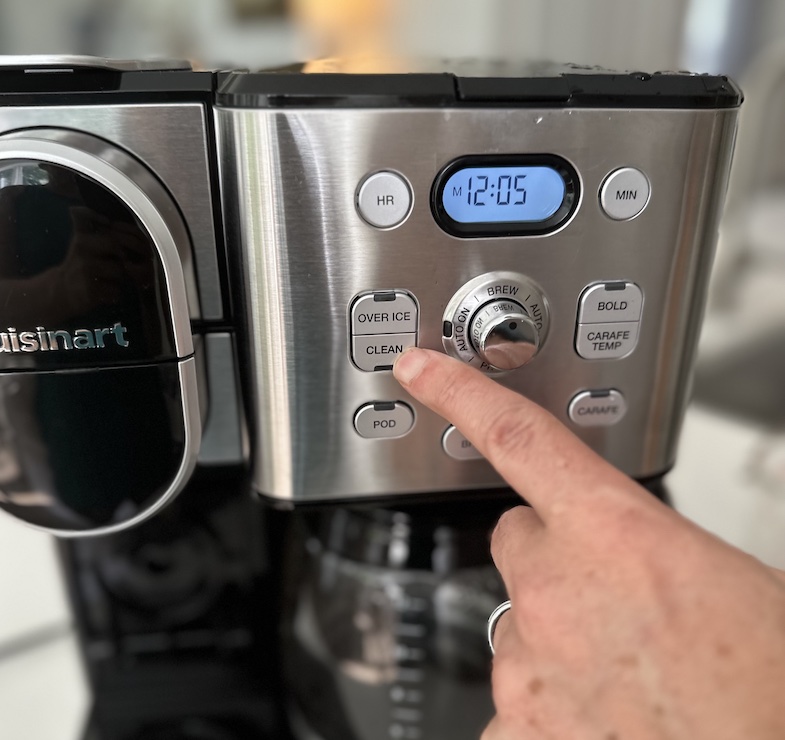We may earn revenue from the products available on this page and participate in affiliate programs. Learn More ›
Though we rely on our coffee makers to deliver that daily cup of joe that will help us get through the morning, most of us neglect it by failing to clean it often enough, or at all. That oversight can have dire consequences. Eventually, scale and coffee oil residue will build up on its internal parts and you’ll wake up to bitter or burnt-tasting coffee.
Luckily, cleaning your coffee maker isn’t a complicated process and doesn’t require you to purchase any special cleaning materials or tools. You can complete this process in less than 30 minutes using supplies you already have in your kitchen. (This isn’t just a lesson in how to clean a Cuisinart coffee maker, though that’s the machine we’re using for this demonstration. These instructions should apply for most machines.)
Before You Begin
While vinegar is an effective and natural cleaning agent to use for a coffee maker, use it in moderation. Vinegar is acidic, so using too high a concentration can damage your coffee maker’s internal parts. Dilute it with water per the manufacturer’s instructions for cleaning the coffee maker. You can also use lemon juice, which is a little less acidic than vinegar, or use one of the alternative methods we describe below.
RELATED: The Best Dual Coffee Makers, According to Our Testing
How to Clean a Coffee Maker with Vinegar

Here’s how to clean a coffee pot using white vinegar, starting with the supplies you’ll need.
SUPPLIES
Toothbrush
Spray bottle
Soft cloth
Mineral oil (optional)
Olive oil (optional)
White vinegar
Step 1: Empty your coffee maker.
You won’t be using plain water to clean your coffee maker, so go ahead and empty the reservoir in the sink.
Step 2: Remove the charcoal filter.

Some coffee makers have a charcoal filter that sits inside the reservoir, removing impurities from the water as it’s drawn into the coffee maker. Remove that filter prior to cleaning the coffee maker, so it doesn’t become saturated with vinegar.
RELATED: The Best Dual Coffee Makers, According to Our Testing
Step 3: Clean the carafe, brew basket, and permanent filter.
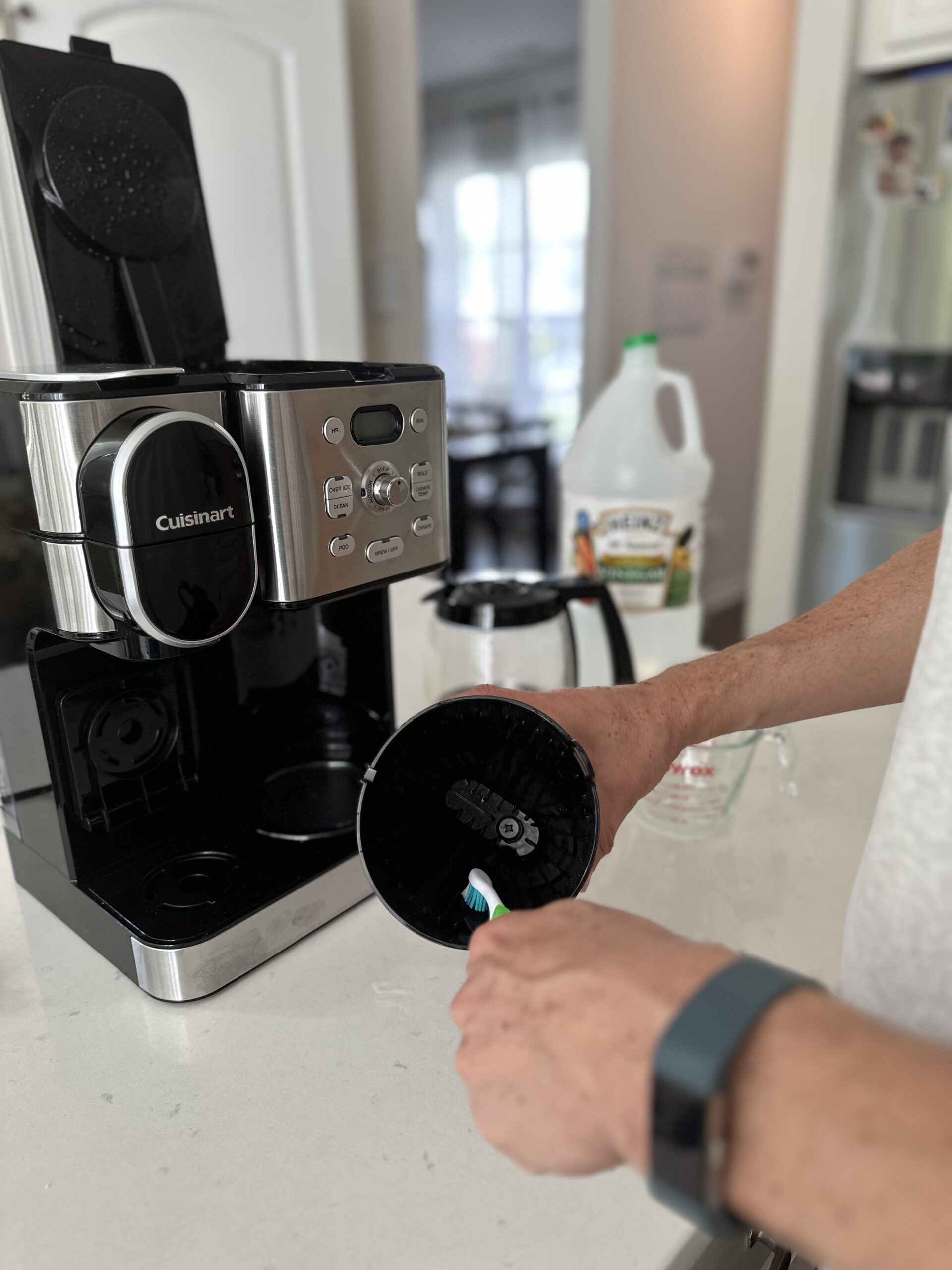
Over time, your coffee maker’s carafe, brew basket, and filter all bear the brunt of acidic coffee grounds. To get your carafe sparkling clean again, add two tablespoons of baking soda into the carafe, then pour in some white vinegar. The solution should immediately start foaming, removing all the hard water marks and coffee stains. As it’s bubbling, take a sponge or rag and wipe out the interior.
Brew baskets have ridges that catch coffee grinds, making them a challenge to clean. Tackle this job by pouring some vinegar into a spray bottle. Soak the brew basket with white vinegar, and allow it to loosen the coffee stains for about 10 minutes. Use an old toothbrush to scrub between the ridges on the basket. Finally, rinse the brew basket with clean water.
You’ll want to give your permanent gold mesh filter a good cleaning too, as the grounds and coffee oils can clog the mesh over time, giving your coffee an odd flavor. Soak the coffee filter in a mixture of one part vinegar to two parts water overnight, then rinse it in the morning.
Step 4: Fill the coffee maker with water and vinegar.
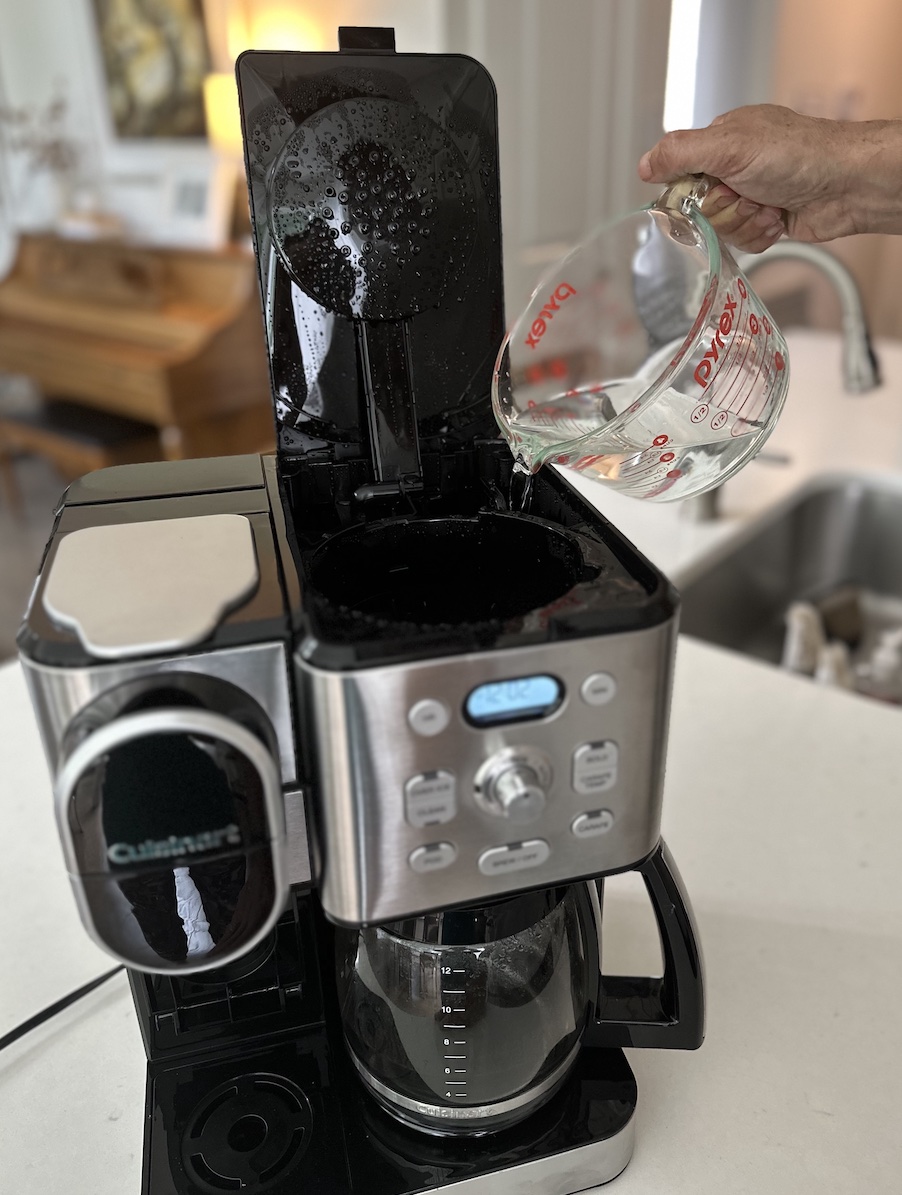
To clean the reservoir, you’ll need to make a solution of water and vinegar. Check the coffee maker’s instructions to determine what concentration of vinegar to use. Cuisinart and Mr. Coffee, for example, advise using half as much water as vinegar.
If you don’t have white vinegar, you can also use apple cider vinegar, though you may need to rinse the coffee maker more thoroughly to get rid of the strong taste. Next, fill the reservoir and place either a permanent filter or paper filter in the brew basket.
Step 5: Run half a brew cycle.
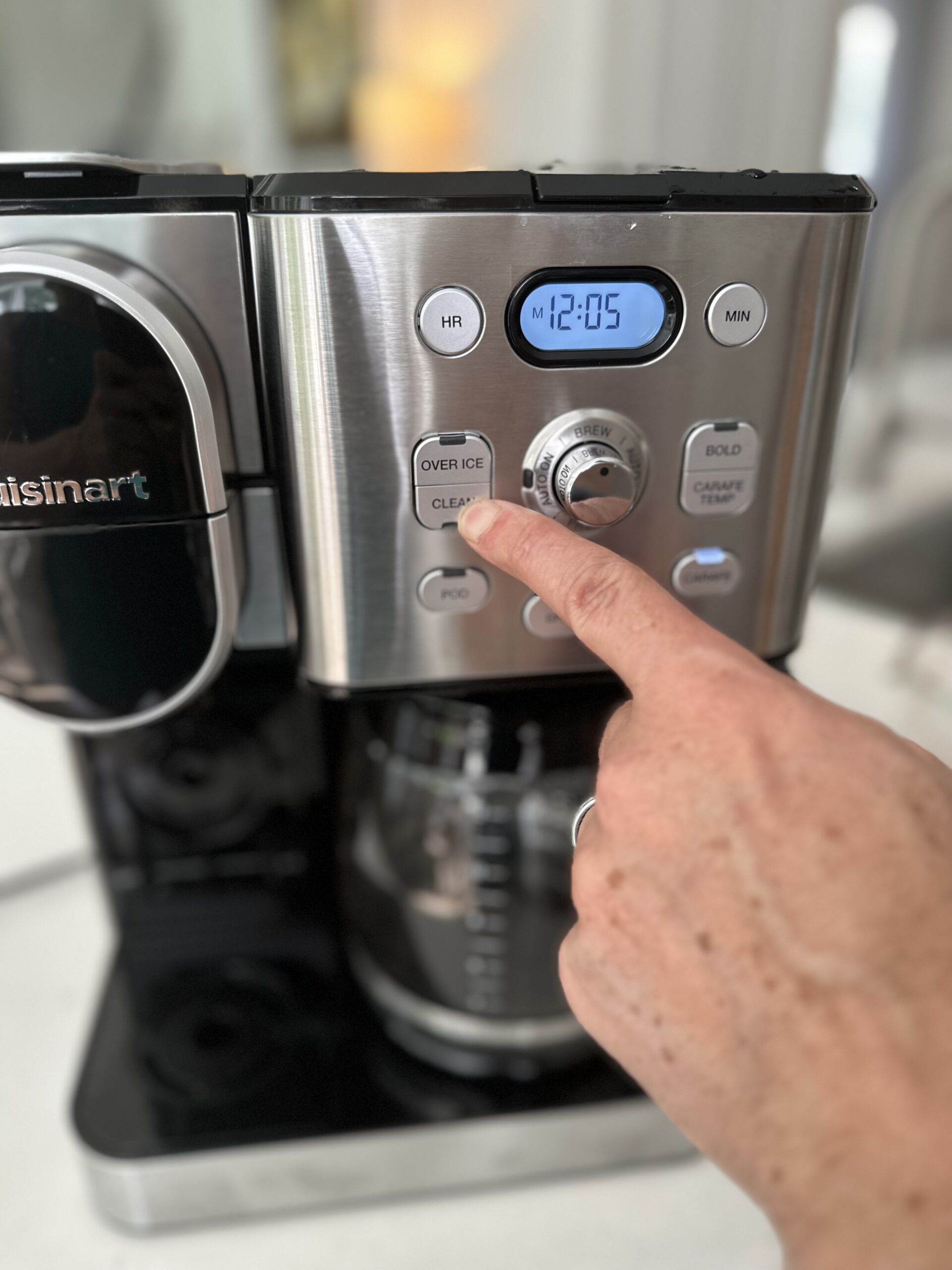
If your coffee maker has a “clean” button, press that button now and allow the machine to cycle all of that vinegar and water mixture into the carafe. You’ll know the clean cycle is over when the coffee maker beeps or the “clean” light goes off.
If you don’t have a clean cycle, simply press the brew button. Once all the water/vinegar mixture is in the carafe, let it sit for 30 minutes to give the vinegar solution a chance to break up any mineral deposits inside the coffee maker, then dump it.
RELATED: 10 Things a Coffee Maker Can Do—Besides Brew Coffee
Step 6: Rinse out the vinegar.
Unless you like the taste of vinegar in your coffee, you’ll want to clear it out of the coffee maker before putting it back into service. Run the coffee maker with a full carafe of pure water and no coffee through two full brewing cycles to rinse out the vinegar.
Step 7: Wipe down the coffee maker.
All that’s left to do before putting your clean coffee maker back into service is to wipe away any dust or coffee drips that have accumulated on its exterior. Spray the exterior with your vinegar solution, then use a soft cloth or sponge to wipe it down. If your coffee maker has a stainless steel finish, you can polish it to a nice shine by dipping a soft cloth into mineral oil or olive oil and wiping it down in the direction of the stainless steel’s “grain.”
How to Clean a Coffee Maker With Baking Soda

The high acidity that makes vinegar such a great cleaning agent also gives it the potential to wear down rubber gaskets and other internal parts that are crucial to your coffee maker’s performance. There’s an alternative cleaning agent in your pantry that’s easier on your coffee maker: baking soda. This natural alkaline dissolves dirt and grease without harming rubber or plastic. Here’s how to clean a coffee maker with baking soda, starting with the supplies you’ll need.
SUPPLIES
Step 1: Empty your coffee maker.
You’ll be creating a solution that you’ll run through your coffee maker, so dump all the water out of your coffee maker’s reservoir.
Step 2: Remove the brew basket and permanent filter.
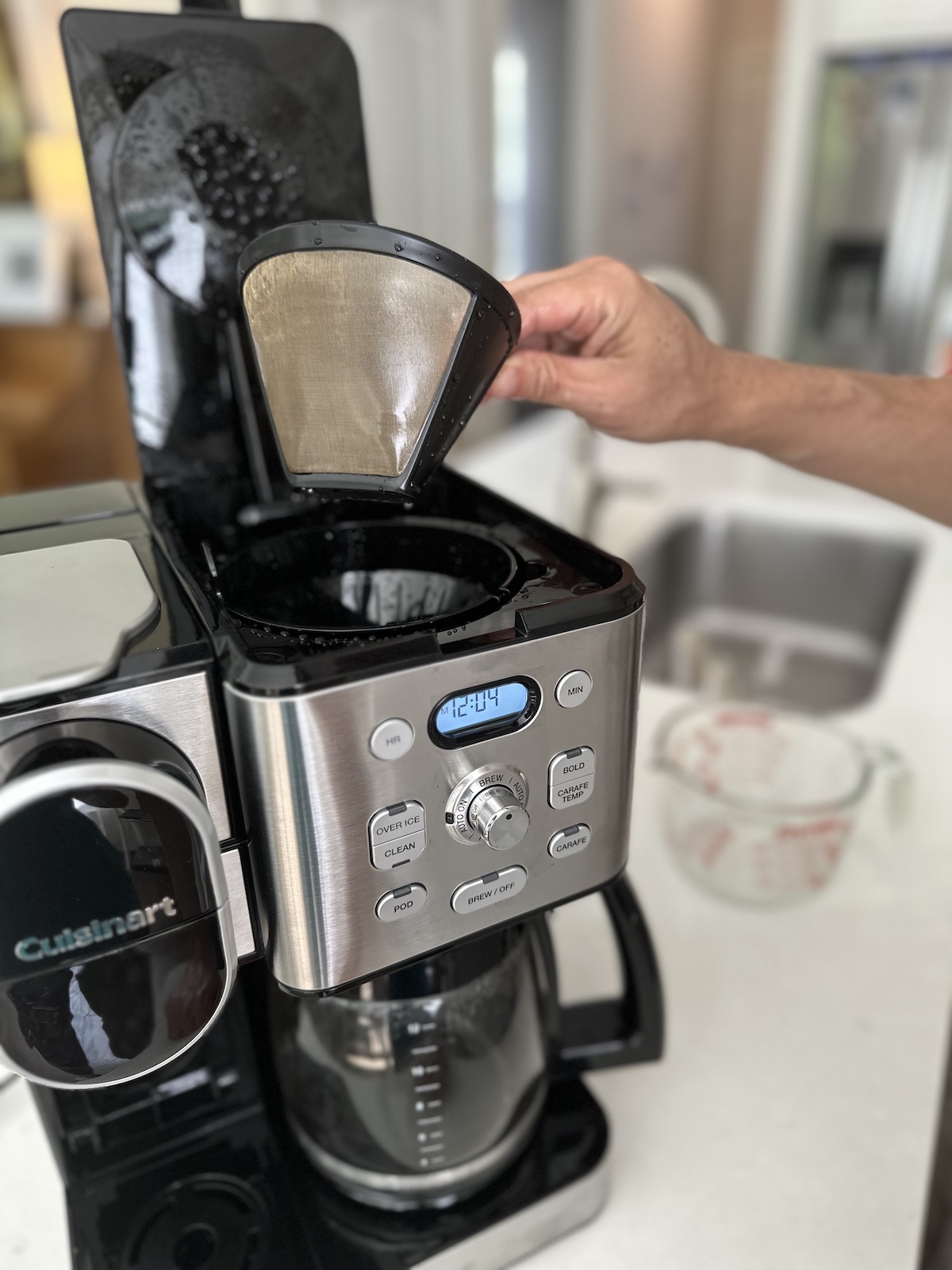
For this cleaning process, you’ll be substituting baking soda for vinegar. Mix a cup of water with a 1/4 cup of baking soda, then dump it into the coffee maker reservoir. Run the solution through a full brewing cycle, dump it, then mix another solution and run it through again. For a very thorough cleaning, run the solution through a third time.
RELATED: 10 Common Kitchen Appliance Mistakes Everyone Makes
Step 3: Wash the brew basket, carafe, and permanent filter.
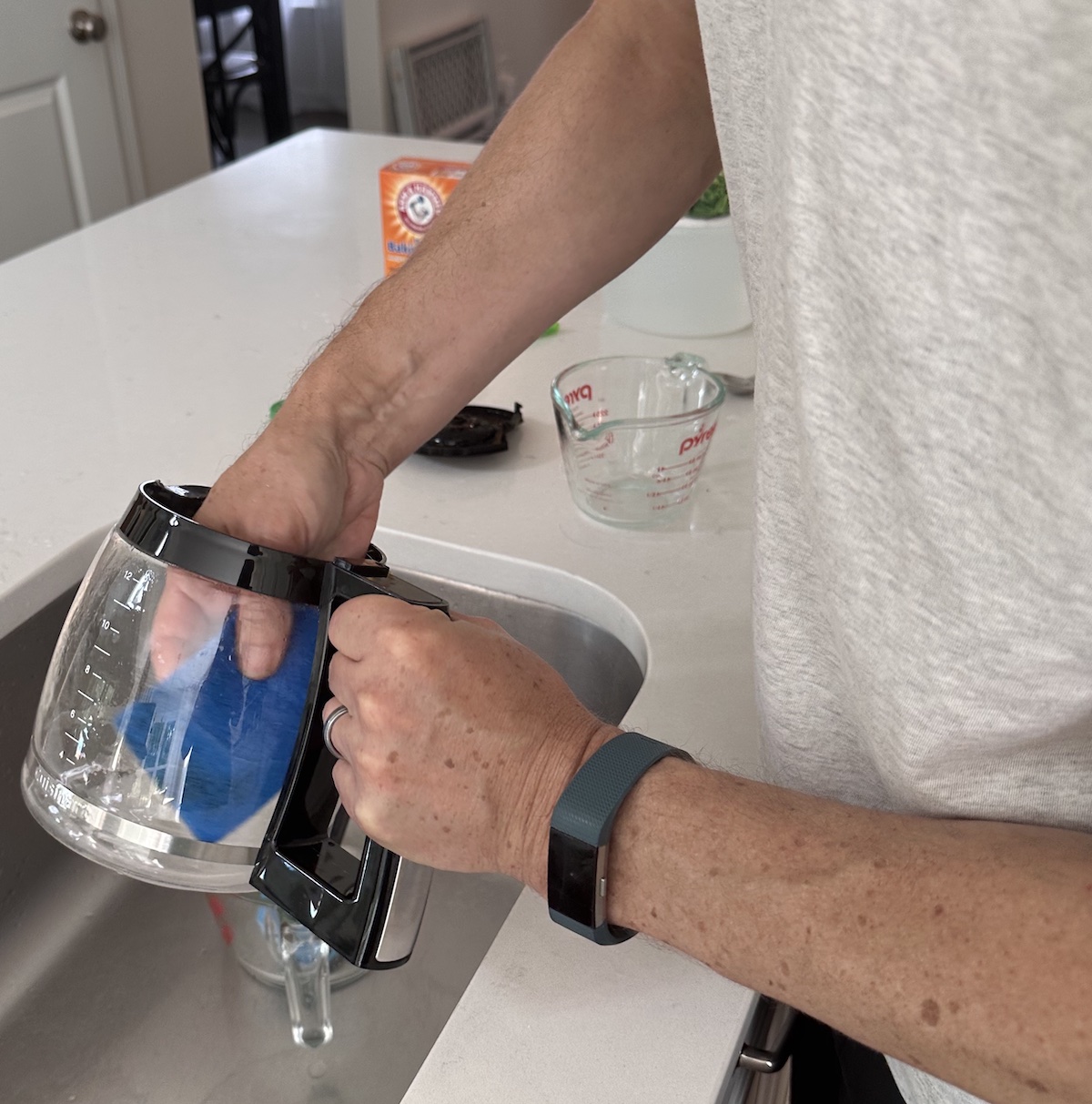
After you’ve run the baking soda through several cycles, make another batch in the carafe. Scrub the glass with a sponge until it’s sparkling clean.
Next, sprinkle some baking soda onto your brew basket and scrub it with a toothbrush to remove buildup caked inside its ridges. Finally, soak the permanent filter in a solution of baking soda and water to dissolve any of the oils that have built up in the mesh. Rinse all three parts thoroughly before putting them back into service.
Step 4: Wipe down the coffee maker.
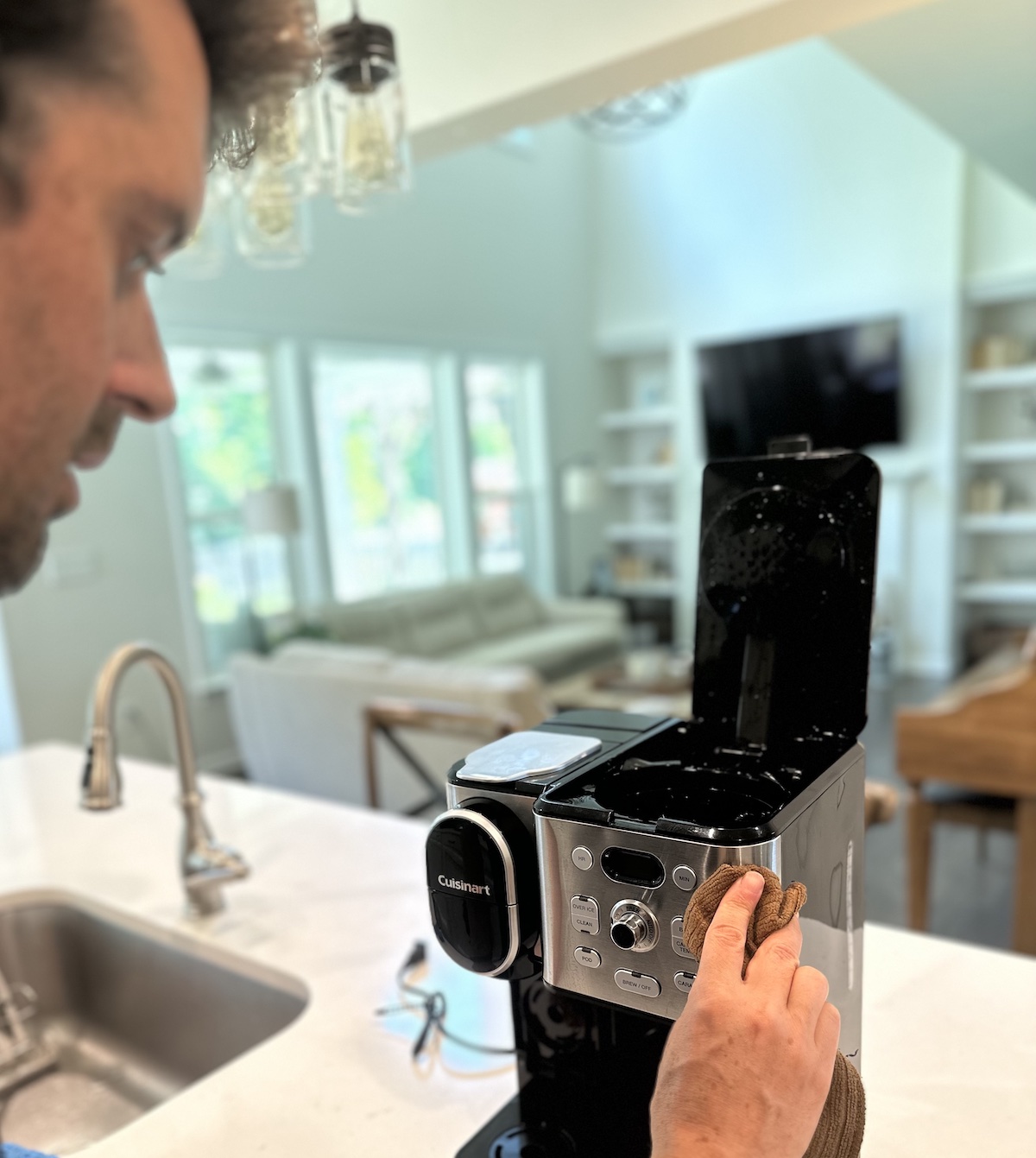
Use a damp cloth to wipe down the coffee maker and remove dust and residue from spills and splashes.
How to Clean a Coffee Maker Using Cleaning Tablets
Most coffee maker cleaning powders and tablets use a combination of powerful acids, including citric acid and sodium bisulfate, to break down scale and coffee oil buildup inside the coffee maker. The main appeal of coffee maker cleaners by Affresh, Urnex Biocaf, and other brands is ease of use.
Rather than mix a solution, all you need to do is drop the tablet or a scoop of powder in a full reservoir and hit the brew button, making it much less likely that you’ll skip your coffee maker’s monthly cleaning. Along with being easier to use, descaling products also don’t have the strong odor that comes with vinegar.
FAQs
If you’re wondering how often you need to clean your coffee maker or what the process is for descaling a Keurig or Nespresso machine, then read on for answers.
Q: How often should you clean your coffee maker?
Clean and descale your coffee maker about once a month if you’re using it every day. If you’re only using it every few days, you can extend your cleaning period to once every two to three months. Some coffee makers have a “clean” button, which will light up when it’s time to clean your coffee maker.
Q: How do you clean a Keurig?
Cleaning a Keurig coffee maker isn’t much different from cleaning a regular coffee maker. Simply fill the reservoir with a descaling product or a solution of vinegar and water, then run the machine several times to remove scale and coffee oil buildup.
Q: How do you clean a Nespresso machine?
Cleaning a Nespresso machine differs from many coffee makers and Keurig machines, as the company advises against using vinegar to descale its machines. Instead, use the Nespresso scaling solution, which you add to the reservoir and run through the machine.
Final Thoughts
You have a few options to choose from when deciding how to clean your coffee maker. Vinegar is one of the easiest and cheapest ways to remove scale from hard water and buildup from coffee grounds and oils from your machine. Baking soda is a nonacidic alternative that’s easier on your coffee maker’s internal parts, while commercial descalers offer ease of use, making it more likely that you’ll stick to your coffee maker cleaning schedule.
